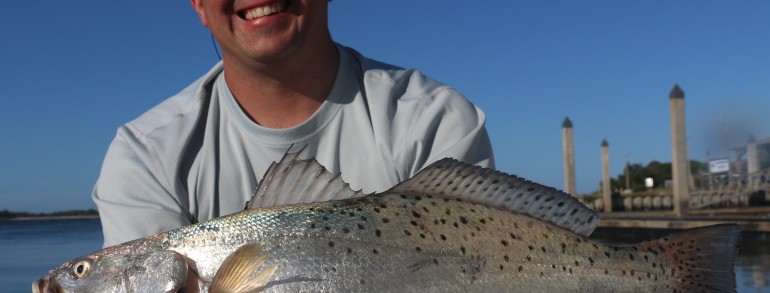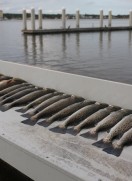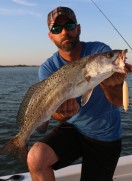This week we're going old school and talking a bit about fishing slip corks for Speckled Trout. We've all been through it before fishing one spot or another where a random old timer in a beat up skiff is next to us spanking the Trout on giant float rigs. Drifting Slip Corks is perhaps the most successful system of Trout fishing ever practiced. This article will explain why, how it works, and how to use them.
Trout are ambush predators. Their eyes are positioned high on the top of their heads and as you can imagine, they tend to hit bait from below as it swims overhead. Trout will sit low in tide breaks such as pot holes in the bottom or on the lee side of a rock pile. Essentially anywhere that blocks current allowing them to sit stationary near the bottom. Because of this, you'll be looking for fishing spots with sharp depth changes or dropoffs. Rocky banks are great candidates when looking for habitat to drift corks for Trout.
In the summer in North East Florida, big Gator Trout tend to head for deeper water. Nothing crazy, but idealy somewhere between 10 and 20 feet of water. You can find them shallower, but this is just to give you a general idea of a consistant starting depth. Here is where slip corks become an invaluable tool. Slip corks are successful because of the ability to fish them in virtually any depth. They can be adjusted simply by sliding a stopper knot below the float allowing you to change it's depth range. Also because of the size of the float, enough weight can be added to the rig to keep the bait near the bottom in raging currents while still covering vast spances of deep water shoreline. This isn't possible with any other rig. Another situation where the ole Slip Cork shines is on boats that don't have a trolling motor. Simply drop the cork in the water and let the current take the bait to the fish.
Your only limitation is your range of vision. When the float becomes difficult to see, reel it back in, rinse and repeat. As a rule of thumb, you'll know if the Trout are home within a few drifts. When it becomes apparent that nothing is biting, or alternately, you're getting bit by trash fish, try adjusting the depth. Remember, Trout are visual predators. If you bring the bait up a few feet, you'll still catch Trout but you may be able to keep the bait away from the pesky trash fish. This will also keep you out of snags.
Like any fishing, tides play an integral role in fishing. If a spot yeilds no fish on one tide, try fishing it on the opposite tide. So long as the current is moving, the rig can be fished with success.
Boat positioning is very important when cork fishing. You'll want the vessel anchored in a way where you can affectively drift multiple bottom depths. Try to avoid anchoring on a flat depth. Always anchore on a depth incline so that you can drift varying depths of bottom. Trout will often be in a certain depth and nowhere else. Keep this in mind when the fish aren't cooperating. Fixing the problem can be as simple as casting off the opposite side of the stern into deeper or shallower water. Just remember to adjust the bobber stopper when casting to a new depth. Idealy, you'll start off by picking a depth similar to what your bottom machine is showing. From there, you start your drift. If the float starts to very slowly pull under water, that means the rig is hitting bottom and you need to shave a foot off the depth with the stopper. Oppositely, if on the first drift you don't get hit, adjust the stopper to go deeper until either you start getting bit or you start hitting bottom. Hitting bottom is a tool that can be used. If you are going too deep and hitting bottom, that tells you you're in the right direction, now all you have to do is come back up a bit.
Lastly, lets talk about the rod and reel used in this type of system. You will defintely want to use a bait caster when drifting corks. The orientation of the spool is the reason. When the bail is open on a spinning reel, the line tends to hang up on the roller arm or on the spool itself. This will defintely drive you up a wall. Baitcasters have a spool postioned facing the same direction that the line is going, hense allowing for a seamless drift with the reel in freespool. You'll also want to use a rod with a softer tip. Trout have fragile mouths and a limber rod will allow for a hook set that isn't so overpowering that you'll pull the hook or rip the fishes mouth. The last bit of advice, always use J Hooks with slip corks. Circle hooks can work but tend to miss the mouth of fish that slash at baits rather then engulfing it. Trout are incredibly annoying about slashing at baits and a circle hook will make the problem worse.
Good luck and keep at it. Slip Corking is definitely an art and requires a bit of patience to master but, once you do, no fish will be safe!
Jacksonville Fishing charters. Jacksonville charter fishing. Guide fishing Jacksonville. Fishing guides Jacksonville. Charter fishing Jacksonville.





admin
Danny Pardue